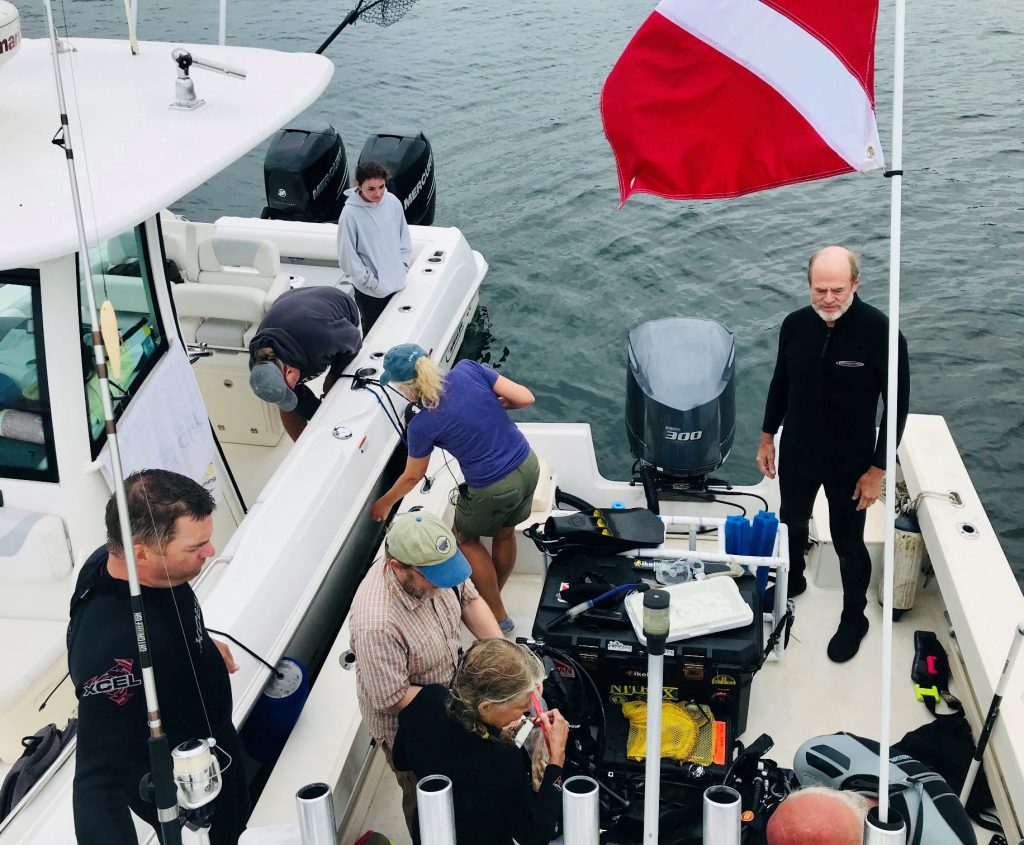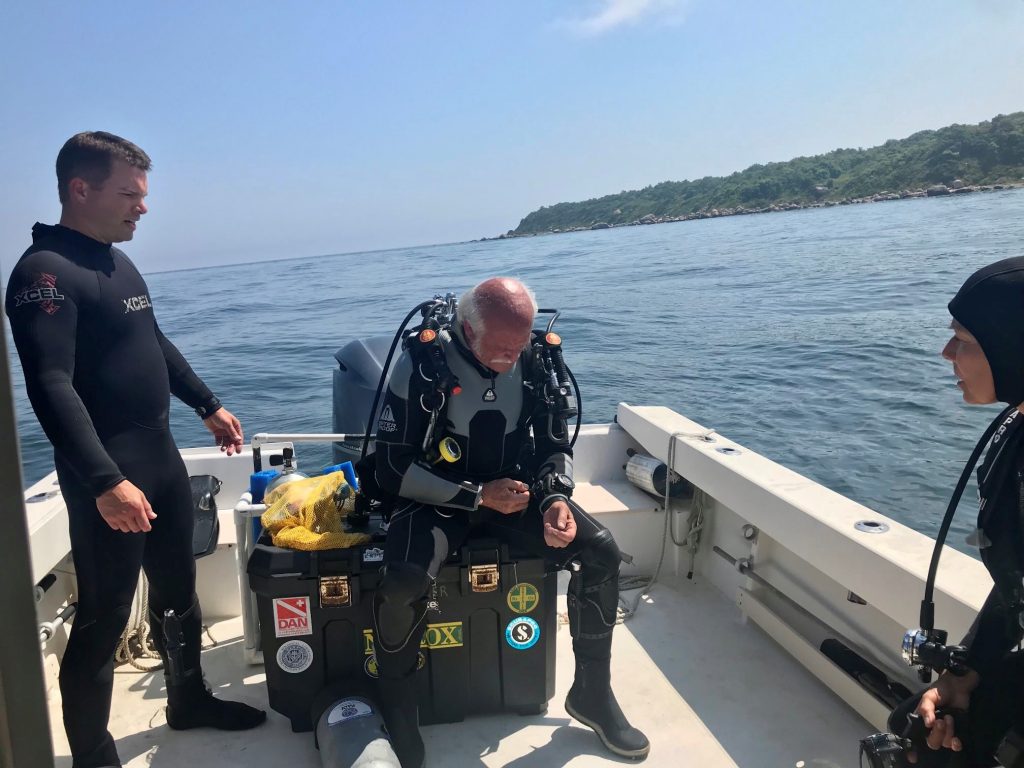NY Natural Heritage Program, Save the Sound, Cornell Cooperative Extension, and more collaborate to deepen understanding of fragile underwater habitats
Orient Point, NY – This week, divers have been conducting a scientific dive using SCUBA in New York State waters off Plum Island, NY, to deepen our shared understanding of the island’s underwater habitats and biodiversity. This effort builds significantly on a 2019 pilot dive that found diverse habitats and abundant life—including coral, anemones, and an eelgrass meadow—near the threatened island.

The dive, conducted by New York Natural Heritage Program (NYNHP), is sponsored by Save the Sound through the generosity of supporters including an anonymous donor who made a challenge match to raise the funds. Save the Sound and the Preserve Plum Island Coalition are working to permanently conserve the federally-owned island and its natural and cultural resources.
Matthew Schlesinger, chief zoologist with NYNHP, explained,
“In the 10 years we’ve been studying the biodiversity of Plum Island, we’ve increasingly recognized the need to understand the surrounding marine ecosystems, which influence what’s on land. No island is an island, if you will. This second set of scientific dives will go a long way toward increasing this understanding, and we thank Save the Sound, InnerSpace Scientific Diving, and our other partners for helping realize this goal.”
Steven Resler of Innerspace Scientific Diving, which is leading the scientific dive, said, “I’ve been intrigued by Plum Island and the waters surrounding it since learning of the area during studies of the region’s marine environment decades ago. Save the Sound and NYNHP are offering this rare opportunity to conduct more ‘science in depth’ below the surface of this treasure in Eastern Long Island Sound.”
“The more we learn about Plum Island’s biodiversity, the more the island holds our region’s fascination,” said Louise Harrison, New York natural areas coordinator for Save the Sound. “From nearshore to upland, the island hosts 25 distinct ecological communities, with numerous endangered, threatened, and rare plant and animal species—at least 111 of conservation concern. To date, 228 bird species have been sighted there. Yet islands don’t end at the waterline: Plum Island’s rich natural habitats are in its marine waters, too. Knowing about the island’s overall biodiversity helps us understand the valuable natural heritage from which we all benefit, in ways we know and countless ways yet to be understood.”
The marine waters surrounding Plum Island include unique and diverse benthic (sea floor) environments, which support vibrant ecological communities and provide suitable habitats for rare species. The current survey focuses on four distinct nearshore subtidal habitat areas identified in the 2019 dive, and documents the presence, distribution, and abundance of marine organisms. Despite the region being long-recognized as an area of ecological importance, this is the first detailed surveying and sampling of the nearshore subtidal areas. Documenting the presence of a variety of benthic species will be a major step in protecting the habitats and species that contribute to these productive communities, and will provide a framework for future scientific studies.
The divers have been conducting transects perpendicular to the island’s shoreline, starting in a water depth of 30 feet and running to a 10-foot depth. Along these paths, they inventory all life within one-meter-by-one-meter squares. With four divers working over five days, the field study is expected to yield substantially more data than the 2019 survey.
Results of the dive will be published by the NYNHP and Save the Sound in the coming months.
A separate dive at the same location was conducted this week by the Cornell Cooperative Extension of Suffolk County’s Marine Program (CCE). Two divers evaluated the health, density, and extent of eelgrass beds around the island, and catalogued the organisms using them. Areas examined include an experimental eelgrass restoration site, as well as natural beds near Plum Island’s southeast shore and just north of its harbor. Cornell Cooperative Extension will share their data with NYNHP for the State’s report, to maximize scientific understanding of Plum Island’s biodiversity.
“The CCE dive team is happy to be involved with this important effort to map the aquatic resources surrounding Plum Island,” said Chris Pickerell, marine program director at CCE. “We have a particular interest in the seagrass meadows that are found in the shallow waters ringing the southeast coast of the island. Given the unique nature of this area, we look to use this site as a reference for future restoration work in the region.”
North Fork resident and environmental enthusiast Paul Ahern said, “My partner Ilene and I are honored to lend our boat and resources to this great project. Our region’s marine environment is vital to our existence and we must protect its beauty and bounty for future generations.”
Meaghan McCormack, Ph.D., marine zoologist with NYNHP, said, “We are super excited to be getting out on the water for a week at the time of year that we expect to see the most diversity and greatest abundance of species. On top of that, we are bringing a total of four divers, two more than on our previous trip in 2019, in hopes that we can collect more detailed information and identify even more marine life.”
Dan Marelli of Scientific Diving International, one of the divers conducting the survey, highlighted the regional value of the research: “Plum Island is unique, not only because of its great diversity of habitats, but also because it lies between major bodies of water that define the nearshore marine environment from Massachusetts to New Jersey.”
Save the Sound’s Long Island Soundkeeper Bill Lucey, who captained one of the staging boats this week, summed up the dives’ value to whole-Sound conservation efforts, saying,
“I’ve spent many hours cruising the coastline of the Sound, from the Bronx and Queens out to Fishers Island and now over to Plum. Much of the coastline is developed, seawalls are common, and space for nearshore-dependent fish and wildlife is dwindling. The coastal habitat around Plum Island holds some of the last wild water to remind us how the shores of Long Island Sound once teemed with life and could again someday.”
Save the Sound thanks the many donors who have made the scientific dives possible; Mr. Paul Ahern for piloting one of the dive boats; Captain Mike Bady of The Captain’s Table; Safe Harbor Marinas in Greenport, NY; Port of Egypt Marina in Southold, NY; Mr. Bob Haase at Duryea’s in Orient Point; Orient Country Store; Silver Sands Motel; and Northeast Diving Services Inc., Ilene Merenstein, Nancy Sernag, and Eddie O’Connor for additional videography.





